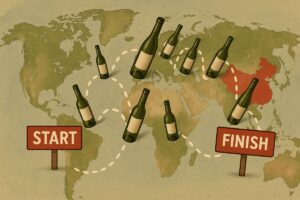
Wine volumes have remained more or less the same, around 24 million hectoliters. The values of wine consumption in Italy, instead — considering that the Covid pandemic marked 2020 and 2021 was only partially better — have grown substantially, growing from less than 12.5 billion euros in 2020 to 13.8 billion euros in 2021, and aiming, in 2022, to return to the nearly 15 billion euros achieved in 2019, the last pre-pandemic year. Recovering values was possible thanks to restaurants reopening, and people starting to consume outside the home again. As we have often said over the last several months, these are absolutely fundamental for higher value wines that are often produced by small and medium-sized wine companies. In 2020, the value of wine consumption in Italy accounted for more than 60% on the mass retail channel, and 39.8% for the “on premise”channel, while 2021 saw mass retail drop to 54.4%, and the HORECA (hotel, restaurant, catering) channel grow to 45.6% (even though it is still far from the 58.6% of the market share reached in 2011). These are the numbers that Denis Pantini (NOMISMA, economic studies consultancy company) presented just recently, in Milan, celebrating the ten years of Società Excellence. The company represents the fundamental link between producers and catering, counting 20 of the major Italian importers and distributors of excellent wines: Sagna, Gruppo Meregalli, Cuzziol Grandivini, Pellegrini, Balan, Sarzi Amadè, Vino & Design, Teatro del Vino, Proposal Vini, Bolis, Les Caves de Pyrene, Premium Wine Selection, Ghilardi Selezioni, Visconti 43, Première, AGB Selezione, Philarmonica, Spirits & Colori, ViteVini and Apoteca. These companies, together, in 2021 yielded more than 260 million euros, thanks to the work of more than 1.800 agents located throughout the National territory, in addition to the indispensable support of 280 collaborators. Furthermore, the member companies of Società Excellence represent and/or are distributors for more than 2100 companies (of which 2/3 are foreign and 1/3 are Italian).
It is the core of Italian wine distribution, which has accompanied profound changes on the Italian wine market. For instance, in terms of types, the boom of bubbles (today representing 25% of wine consumption), which have “stolen” the market in value from still whites (that are down from 38% in 2011 to 36% in 2021) and, above all, from red wines (from 38% to 32%), while rosés are stable (at 7%). Then there are the trends, as Pantini pointed out, “a great many surveys have revealed that more and more consumers, especially now after the Pandemic, are asking for types of wines that pay great attention to healthiness and sustainability, including low alcohol wines. This trend indicates greater market segmentation, which will require even more specialization”. Therefore, it will be more complex, as well as creating new spaces for the future.
“The role of distribution, and its ability to be the link between the production world and the retail and HORECA channels, are all necessary elements, even in this challenging and complicated moment characterizing the post-pandemic period”, Lorenzo Righi, Director of Società Excellence said. “Knowing how to manage the delicate phase of logistics today”, he added, “has assumed a central role in wine distribution, just like continuing training courses in the sales force: The member companies of Società Excellence carry out these activities with great enthusiasm, spreading knowledge about new quality productions, which more and more need professional and expert partners by their sides”.
“One of the objectives of Società Excellence”, the president, Luca Cuzziol, said, “is to imagine the future. Last year, wine yielded a turnover of 13.1 billion euros, of which a record 7.1 billion euros for exports, which means there are 6 billion euros of business in Italy, and we weigh less than 300 million euros. It also means that we have 10-lane highways in front of us. I am convinced that the wine distributed is no longer just good, but better on our customer’s tables, because there is an extra passage that adds a plus to it. Our companies have poured energy into the important training part — they have teamed up. They created the “Modena Champagne Experience” (to be held October 16-17, 2022, in Modena, ed.), for instance, which may seem simple, but it is not. We asked ourselves a lot of questions, we forced ourselves to bring great wines and let them be tasted. And, to make sure that there is greater knowledge of this product. The people who have deep roots”, Luca Cuzziol said, “will take home results. I hope that tomorrow many more will understand that a distribution structure is fundamental for their company. However, I would like to see more transparency in the wine world, because there are still rules in place that are not exactly orthodox. “Land income” is not always helpful, since in Italy a farm that has 200.000 euros in turnover continues to operate, while in France it would not because they have a higher tax rate. We need more transparency from producers. We are doing our part. We are sharing our experiences in the sales network, our financial statements are public, and we have given ourselves a code of ethics. There is room for everyone, but we should increase training courses, perhaps together, as Marcello Meregalli’s proposal has suggested. It is essential for those who sell wine to have training. I am not saying they need a degree in enology, but we shouldn’t think or communicate that a wine is “natural”, suggesting that the others are “chemical” ...? In general, we have to work all together, like we did to get better payment times, and together, we have all improved, because from averages of over 100 days we have reached 60-70 days. This proves that teaming up, forming community and being together brings more to the table”.
Copyright © 2000/2025
Contatti: info@winenews.it
Seguici anche su Twitter: @WineNewsIt
Seguici anche su Facebook: @winenewsit
Questo articolo è tratto dall'archivio di WineNews - Tutti i diritti riservati - Copyright © 2000/2025